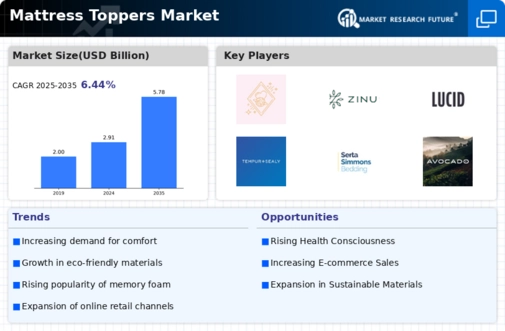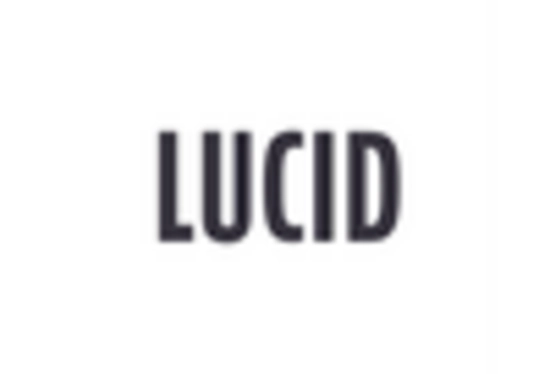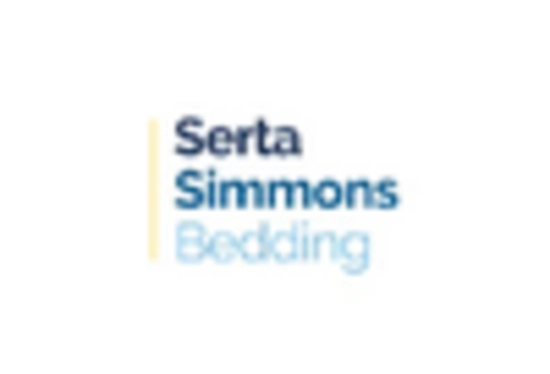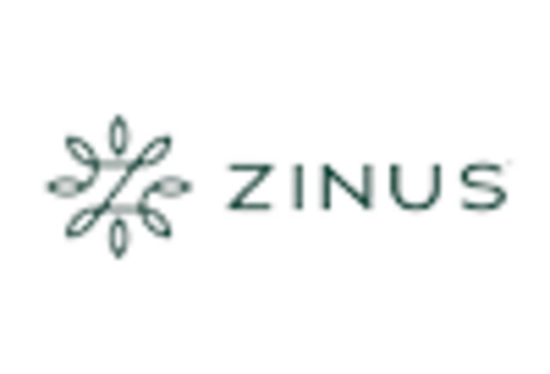Growing E-commerce Penetration
The Mattress Toppers Market is benefiting from the rapid growth of e-commerce platforms. As consumers increasingly prefer online shopping for its convenience and accessibility, mattress topper sales through digital channels are on the rise. Data indicates that e-commerce sales in the home goods sector have surged, with mattress toppers being a popular category. This shift towards online purchasing is prompting manufacturers to enhance their digital marketing strategies and optimize their online presence. Additionally, the availability of customer reviews and detailed product information online is empowering consumers to make informed purchasing decisions. Consequently, the Mattress Toppers Market is likely to see sustained growth as e-commerce continues to reshape consumer buying behavior.
Increased Focus on Health and Wellness
The Mattress Toppers Market is witnessing a surge in demand driven by an increased focus on health and wellness. Consumers are becoming more conscious of the impact of sleep on overall health, leading to a greater willingness to invest in products that promote better sleep quality. Mattress toppers, known for their ability to enhance comfort and support, are increasingly viewed as essential components of a healthy sleep environment. This trend is further supported by the rise of wellness-oriented brands that emphasize the health benefits of quality sleep. As a result, the Mattress Toppers Market is likely to expand as more consumers prioritize their well-being and seek out products that contribute to improved sleep experiences.
Technological Advancements in Materials
Technological advancements in materials are significantly influencing the Mattress Toppers Market. Innovations such as memory foam, gel-infused materials, and breathable fabrics are enhancing the functionality and appeal of mattress toppers. These advancements not only improve comfort but also address specific consumer needs, such as temperature regulation and pressure relief. The introduction of smart mattress toppers, equipped with sensors to monitor sleep patterns, is also gaining traction. This trend is indicative of a broader movement towards integrating technology into sleep products, which is expected to attract tech-savvy consumers. As a result, the Mattress Toppers Market is likely to witness increased competition among manufacturers aiming to leverage these technological innovations to capture market share.
Sustainability and Eco-Friendly Products
Sustainability is emerging as a key driver in the Mattress Toppers Market, as consumers increasingly seek eco-friendly products. The demand for sustainable materials, such as organic cotton and natural latex, is on the rise, reflecting a broader trend towards environmentally responsible consumption. Manufacturers are responding by developing mattress toppers that not only provide comfort but also adhere to sustainable practices. This shift is likely to attract environmentally conscious consumers who prioritize sustainability in their purchasing decisions. Furthermore, the Mattress Toppers Market may see growth as brands that emphasize eco-friendly attributes gain traction among consumers looking to reduce their environmental footprint.
Rising Consumer Awareness of Sleep Quality
The Mattress Toppers Market is experiencing a notable increase in consumer awareness regarding the importance of sleep quality. As individuals become more informed about the health implications of inadequate sleep, they are increasingly seeking solutions to enhance their sleep environment. This trend is reflected in the growing demand for mattress toppers, which are perceived as effective tools for improving comfort and support. According to recent data, the market for sleep-related products, including mattress toppers, is projected to grow at a compound annual growth rate of approximately 6% over the next five years. This heightened focus on sleep health is likely to drive innovation and diversification within the Mattress Toppers Market, as manufacturers strive to meet evolving consumer preferences.

















Leave a Comment